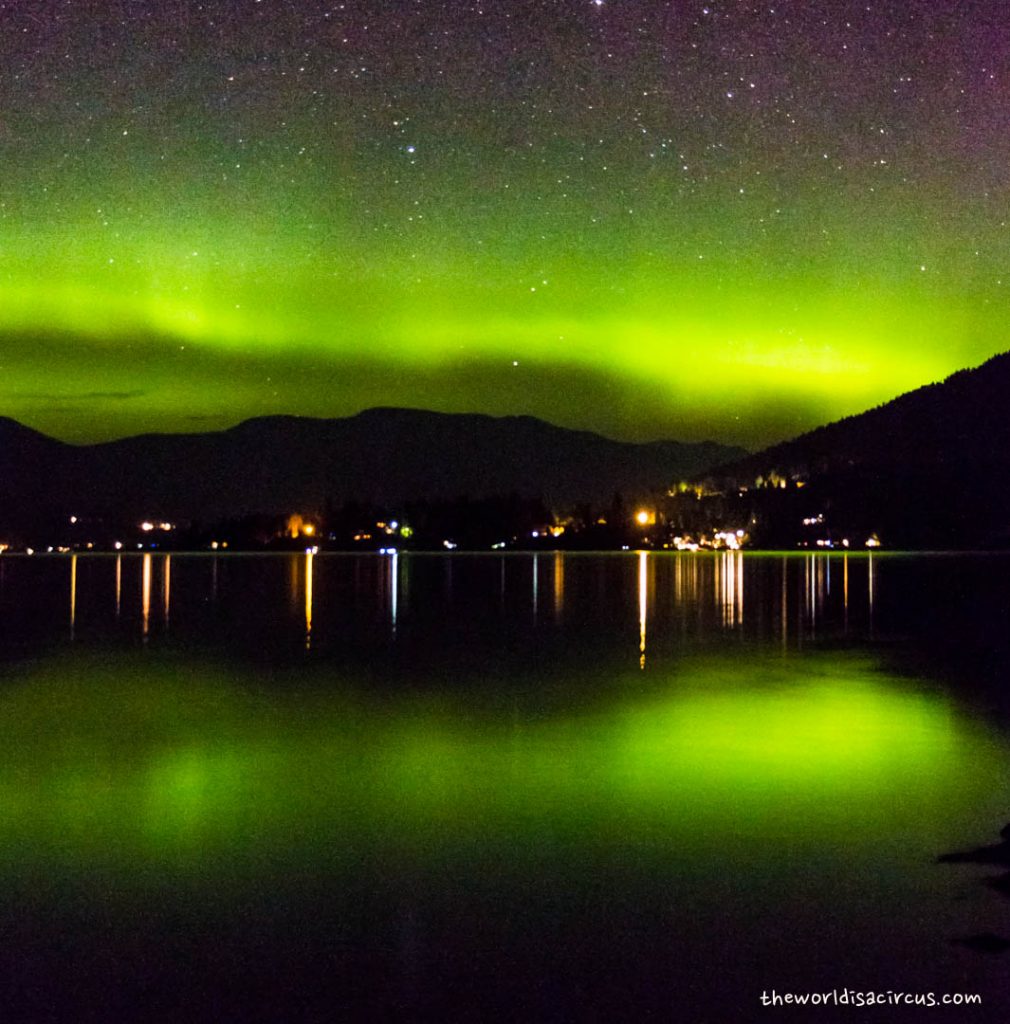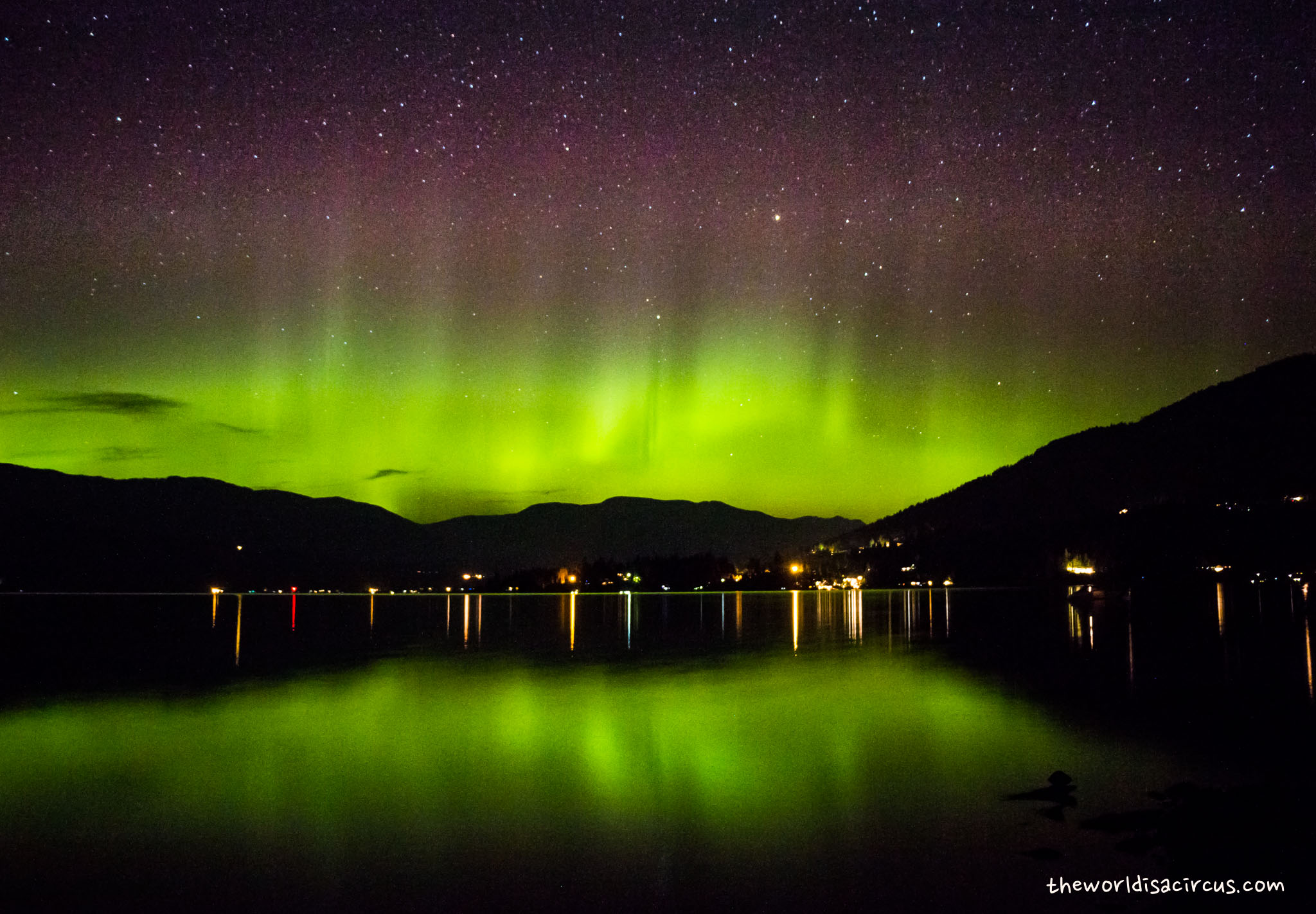We were driving on the Trans-Canada Highway and I was fighting to keep my eyes open, when it happened. Green, dancing lights across the night sky.
My first aurora! I still can’t believe it. It couldn’t be more random. We were just on our way to Canmore, trying to kill some kilometres. It was 10.30pm when Nico suddenly shouted: “Oooh shit”. I don’t remember his exact words, but I thought we were caught by the bushfires. Luckily I got a treat when I opened my eyes.
THE NORTHERN LIGHTS!

Just on our left. Dancing like a wave of the sea.
We immediately looked for a lake nearby, and found one in Sorrento (B.C.). Tripods out (how else are you going to capture the lights?), cameras out and there we went.
The beauty of it touched me. Green strokes of light dancing in the sky, it is something special. On top of that we got some beautiful reflections in the lake. It makes you remember again how freaking incredible this world is.
What is an aurora actually?
The Aurora Borealis is also called the northern lights, or in the southern hemisphere it is Aurora Australis and southern lights. You’ll see green, pink and blue colours across the night sky, often dancing.
The name comes from astronomer Galileo Galilei, who named it aurora borealis in 1619. He was inspired by the name of the Roman goddess of the dawn: Aurora, and the Greek name for wind of the north: Boreas.
What causes these beautiful lights to appear?
Nature puts on a show with its northern and southern lights, but how does it happen? What causes it? It isn’t just to please us; there is a logical explanation.

Here I go:
It’s all about the sun. Storms on the sun send solar particles across space.
The northern lights are actually collisions between those electrically charged particles from the sun, entering the earth’s atmosphere. When those particles from the sun strike atoms and molecules in our atmosphere, they light up, treating us on a spectacle.
Here’s a little video of our wonderful night:
When and where is the best time to spot the northern lights?
Definitely not in summer, so Nico and I were very lucky. Winter is usually the best period, as there is less light pollution and the air is clear and crisp.
The best places to see the northern lights are northern Canada (yes!) and Alaska. Norway, Sweden, Finland and Iceland also have good vantage points.
Be prepared, so you can get your camera out! The Space Weather Prediction Centre and NASA are good resources. It’s important to check the KP Index, indicating how intense the storm is. The index goes from 0 to 9, and you definitely want a KP Index of 5 or higher. The higher, the stronger the lights will be.
https://www.nasa.gov/mission_pages/sunearth/aurora-news-stories/index.html
http://www.aurora-service.eu/aurora-forecast/
There are also lots of Aurora Facebook groups, sharing aurora predictions and sightings.
PIN NOW, READ LATER

I’m ready to see more of those dancing lights!


I love your photos, best of the northern lights I have ever seen! Can you provide your camera specs and what kind of tripod that you used?
Thanks so much for your nice comment! I shoot with a Canon 70D, and my camera settings were: 18mm / 10sec / f 3.5 / ISO 800.
This is so cool babe! Definitely a dream to see this myself one day!
I’m sure you will!
This is amazing!!! This is absolutely on my bucket list! Thanks for sharing!
Thanks so much 🙂 I hope you spot an aurora too!